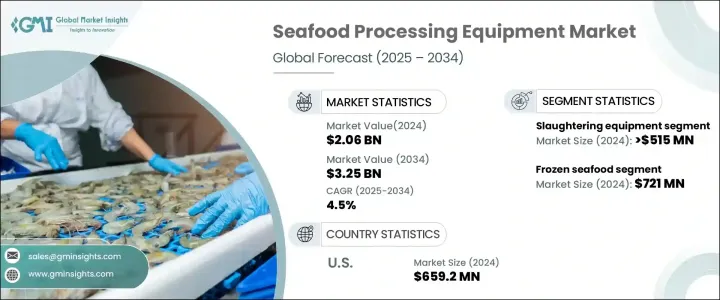
세계 수산 가공 장비 시장은 2024년 20억 6,000만 달러로 평가되었으며, 2025년부터 2034년까지 4.5%의 안정적인 CAGR로 성장할 것으로 예상됩니다.
인구 증가와 식생활의 선호의 변화에 추진된 수산물 수요 증가가 이 성장의 주요 원동력이 되고 있습니다. 소비자의 건강 지향이 높아짐에 따라 수산물, 특히 오메가 3 지방산의 함량이 건강에 좋다는 인식이 정착하고, 수산물 소비는 증가의 길을 따라가고 있습니다. 이러한 식습관의 변화와 지속 가능한 조달에 대한 관심이 높아져 효율성과 환경 기준을 모두 충족할 수 있는 고급 가공 솔루션에 대한 요구가 높아지고 있습니다. 식품 가공 기술의 끊임없는 진화에 따라 업계에서는 기술 혁신, 전반적인 생산성 향상 및 지속가능성 목표에 맞는 제품 창출에 많은 투자가 이루어지고 있습니다.

그러나 수산가공시장은 환경의 지속가능성에 관한 과제에 직면하고 있습니다. 남획, 혼잡, 가공 기술의 탄소 풋 프린트와 같은 문제는 수산물의 조달 방법과 취급 방법에 영향을 미치는 긴급한 과제입니다. 이러한 환경 의식 증가는 업계 동향을 형성하고 있지만, 동시에 특정 가공 방법의 채용을 방해할 수 있는 위험도 야기하고 있습니다. 이러한 과제는 기업이 수요와 생태계에 대한 책임 사이의 균형을 맞추기 위해 일부 분야에서 시장 성장을 둔화시킬 수 있습니다.
| 시장 범위 | |
|---|---|
| 시작연도 | 2024년 |
| 예측연도 | 2025-2034년 |
| 시작금액 | 20억 6,000만 달러 |
| 예측 금액 | 32억 5,000만 달러 |
| CAGR | 4.5% |
축산 장비 부문은 2024년에 5억 1,500만 달러의 수익을 창출했으며, 이 부문은 엄격한 위생 기준을 유지하면서 수산 가공업자의 업무 효율을 보장하는 데 매우 중요합니다. 수산물의 인기가 증가하고 양식이 확대됨에 따라 최첨단과 축축한 시스템에 대한 큰 수요가 있습니다. 자동화를 통합한 최신 시스템은 높은 식품 안전 기준을 유지하면서 인건비를 줄이고 생산성을 향상시키는 데 도움이 됩니다. 자동화는 특히 대규모 가공처리를 하는 지역에서 보다 높은 처리능력과 전반적인 효율성을 가능하게 하고, 기업이 낮은 운영비용으로 증가하는 수요에 대응할 수 있게 합니다.
2024년에는 냉동수산물 분야가 7억 2,100만 달러에 달할 것으로 추정되며, 2034년까지 4.5%의 연평균 복합 성장률(CAGR)로 성장할 것으로 기대되고 있습니다. 냉동은 영양가 유지와 보존 기간의 연장에 도움이 되므로 수산물 보존 방법으로 선호되고 있습니다. 냉동 제품의 편의성은 시간이 지남에 따라 품질을 유지할 수 있다는 점에서 기업과 소비자 모두에게 인기있는 선택입니다. 이러한 추세는 신선도를 유지하면서도 오래 보관하기 쉽고 보관 공간을 많이 차지하지 않는 해산물 제품에 대한 지속적인 선호도를 강조합니다.
미국의 수산 가공 장비 시장은 2024년 6억 5,920만 달러에 이르렀으며, 세계 시장에서 압도적인 점유율을 차지하고 있습니다. 미국 시장은 2025년부터 2034년까지 수산물 소비 증가로 크게 성장할 것으로 예상됩니다. 소비자의 선호가 필렛이나 냉동 어패류 등, 곧바로 먹을 수 있는 수산물로 변화함에 따라, 이러한 제품을 대량으로 효율적으로 처리할 수 있는 가공 기기에 대한 수요가 높아지고 있습니다.
The Global Seafood Processing Equipment Market was valued at USD 2.06 billion in 2024 and is expected to expand at a steady CAGR of 4.5% from 2025 to 2034. The rising demand for seafood, fueled by growing populations and changing dietary preferences, is a primary driver of this growth. As consumers become increasingly health-conscious, the recognition of seafood's health benefits, particularly its omega-3 fatty acid content, continues to boost its consumption. This shift in eating habits, combined with a greater focus on sustainable sourcing, has heightened the need for advanced processing solutions that can meet both efficiency and environmental standards. With the continuous evolution of food processing technologies, the industry is seeing substantial investments in innovation, improving overall productivity, and creating products that align with sustainability goals.

The seafood processing market, however, faces challenges tied to environmental sustainability concerns. Issues such as overfishing, bycatch, and the carbon footprint of processing technologies are pressing matters that influence how seafood is sourced and handled. This increased environmental awareness is shaping industry trends but also poses risks, potentially hindering the adoption of certain processing methods. These challenges may slow the market's growth in some areas as businesses work to balance demand with ecological responsibility.
| Market Scope | |
|---|---|
| Start Year | 2024 |
| Forecast Year | 2025-2034 |
| Start Value | $2.06 Billion |
| Forecast Value | $3.25 Billion |
| CAGR | 4.5% |
The slaughtering equipment segment is projected to generate USD 515 million in 2024. This segment is crucial in ensuring the operational efficiency of seafood processors while maintaining strict hygiene standards. With the growing popularity of seafood and the expansion of aquaculture, there is a significant demand for cutting-edge slaughtering systems. Modern systems, which integrate automation, help reduce labor costs and improve productivity while maintaining high food safety standards. Automation, especially in regions with large-scale processing operations, enables higher throughput and overall efficiency, allowing companies to meet growing demands at a lower operational cost.
In 2024, the frozen seafood segment is estimated to be worth USD 721 million, with expectations for it to grow at a 4.5% CAGR until 2034. Freezing is the preferred method of preserving seafood as it helps retain its nutritional value and extends shelf life. The convenience of frozen products, coupled with their ability to maintain quality over time, has made them a popular choice for both businesses and consumers. This trend highlights the continued preference for long-lasting, easy-to-store seafood options that do not compromise on freshness.
The U.S. seafood processing equipment market reached USD 659.2 million in 2024, holding a dominant share of the global market. Projections show significant growth in the U.S. market between 2025 and 2034, primarily driven by an increase in seafood consumption. As consumer preferences shift toward ready-to-eat seafood products, such as fillets and frozen seafood, there is a rising demand for processing equipment that can efficiently handle large volumes of these products at scale.